Easter in Puglia can feel like a dark and solemn time because of the region’s deeply ingrained religious traditions and the somber nature of the Holy Week rituals. Puglia is a predominantly Catholic region, and the people take their religious beliefs and practices very seriously.
During Holy Week, which is the week leading up to Easter, many towns in Puglia hold elaborate processions and ceremonies to commemorate the Passion and Death of Christ. These rituals are often marked by solemn music, prayers, and the use of symbols and images that evoke feelings of sorrow and mourning.
The penitential rituals, such as self-flagellation, practiced by some religious brotherhoods in Puglia during Holy Week, can also contribute to the sense of solemnity and gravity of the occasion. These practices are meant to be a form of devotion and penance. They are a testament to the deep faith and religious commitment of the people of Puglia.
In addition, the traditional costumes worn by participants in the Holy Week rituals, such as the Pappamusci, are often dark in color and add to the somber atmosphere of the occasion, at times even appearing sinister.
This is the most sacred time of the year. A time when the religious traditions and cultural heritage of our region come to the fore. For visitors it is a unique time to experience the authentic customs and rites that have been passed down through generations.
Tradition and ritual
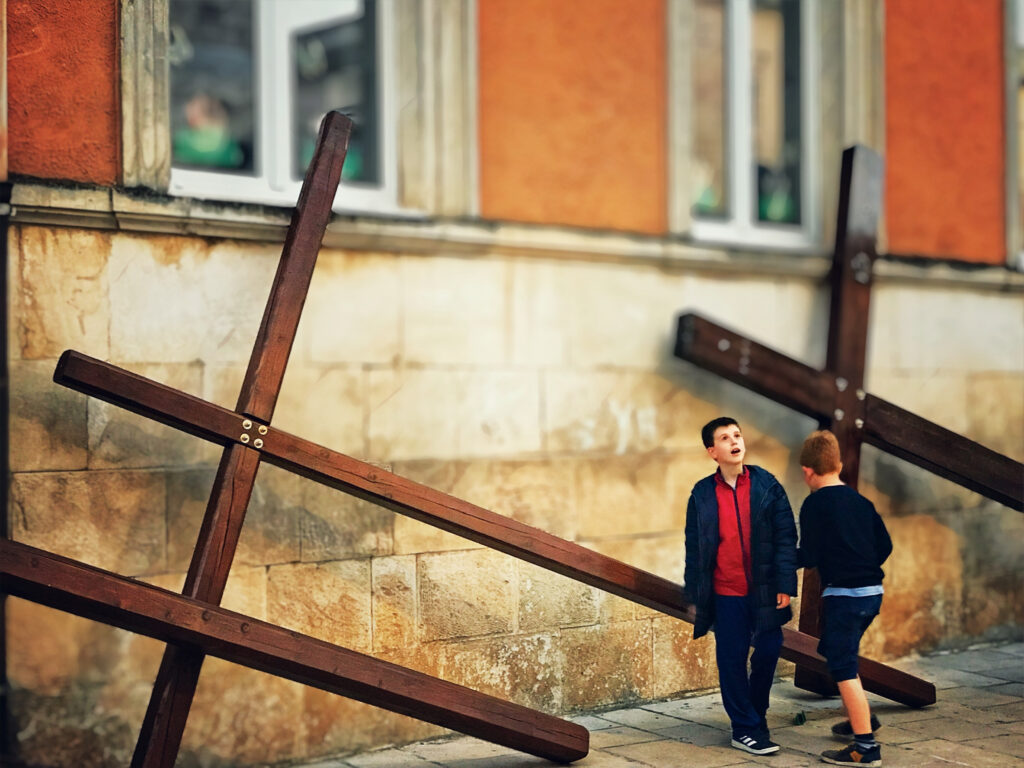
The week leading up to Easter is a time of deep religious significance in Puglia, and each town and village has its own unique traditions and customs. One of the most famous of these is the Processione dei Misteri, or the Procession of the Mysteries, which takes place in the historic town of Taranto.
During this procession, life-size statues of the Passion of Christ are carried through the streets by the local confraternities, or brotherhoods, accompanied by haunting music and the wailing of mourners. The atmosphere is somber and solemn, and it is impossible not to be moved by the devotion and passion of the participants.
Whether you are a believer or not, there is something deeply moving about the devotion and passion that is on display during this time of year.

Another important tradition in Puglia is the preparation of the Scarcella, a type of sweet bread that is baked in the shape of a lamb or other animal. The Scarcella is typically made by the women of the family, and is often given as a gift to friends and neighbors during Holy Week.
In the town of Martina Franca, the focus is on the ancient ritual of the Vattienti. This involves a group of men who whip themselves with chains and cords as a form of penance and devotion. The ritual is not for the faint of heart, but it is a powerful reminder of the sacrifices that are made during this holy time.
Throughout Puglia, there are also many smaller traditions and customs that add to the unique character of the region during Holy Week. From the lighting of candles in the streets to the traditional foods that are eaten during this time, visitors will find themselves immersed in a rich and ancient culture that has been preserved for centuries.
As you explore the towns and villages of Puglia during Holy Week, take the time to appreciate the beauty and depth of the traditions that you encounter. Whether you are a believer or not, there is something deeply moving about the devotion and passion that is on display during this time of year.
Martina Franca | the Vattienti
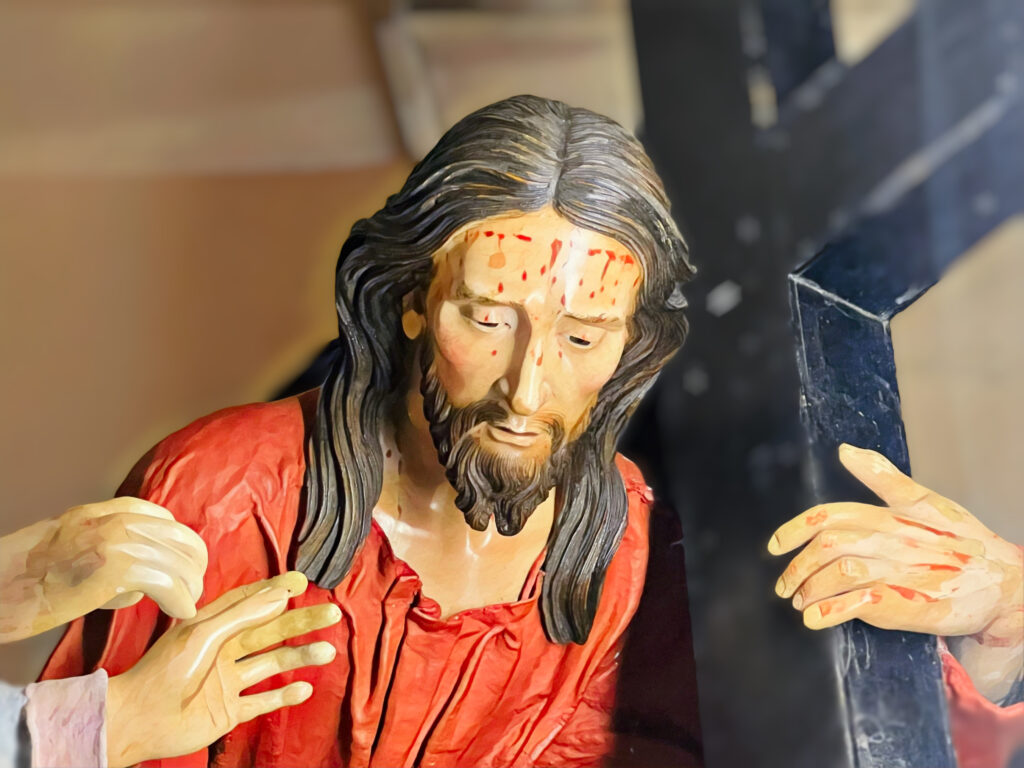
The Vattienti are a group of penitents who engage in the ancient ritual of self-flagellation as a form of religious devotion.
The self-flagellation of the Vattienti is a unique and intense Holy Week ritual practiced in some parts of Puglia. The Vattienti are men who participate in this ritual, which involves whipping themselves with chains and cords as a form of penance and devotion.
The Vattienti are usually dressed in white robes and hoods that cover their faces, and they walk through the streets of the town barefoot. As they walk, they beat their backs and legs with the chains and cords, which are often adorned with sharp hooks and spikes.
The sound of the chains hitting their skin is loud and rhythmic, and it echoes through the streets. The Vattienti move in a slow and deliberate manner, and the pain they experience is evident on their faces.
Despite the graphic nature of this ritual, it is deeply meaningful for the Vattienti and for those who witness it. The self-flagellation is seen as a way to share in the suffering of Christ and to demonstrate a deep commitment to their faith.
The ritual is not for the faint of heart, and some people find it difficult to watch. However, for those who participate in it or who understand its significance, it is a powerful reminder of the sacrifices that were made during the Passion of Christ and the depth of devotion that is possible.
It is worth noting that not all religious communities in Puglia practice self-flagellation, and the ritual is controversial even among those who do. However, for those who do practice it, it is a powerful and deeply meaningful expression of their faith and devotion.
Their unique ritual is a testament to the enduring power of religious devotion and cultural tradition in this region of Southern Italy.
Francavilla Fontana | the Pappamusci
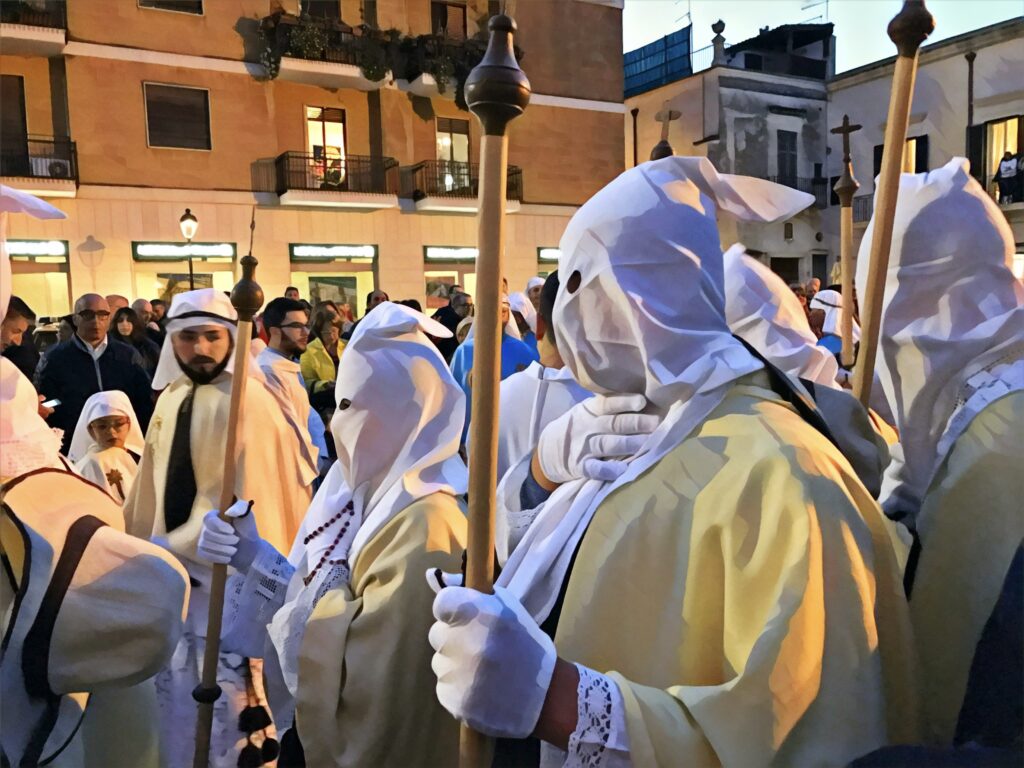
The Pappamusci from Francavilla Fontana are also a traditional part of the Holy Week celebrations in Puglia. Francavilla Fontana’s Holy Week traditions are known for their unique and elaborate costumes.
They appear menacing due in part to the ‘Pappamusci’, a distinctive part of the costume worn during the ritual. They are large, cone-shaped hats that are made from layers of black or dark purple cloth, and are often adorned with a large tassel at the top. They are similar to those worn by the Vattienti of Martina Franca. However, there are some differences in the shape and style of the hats in Francavilla Fontana, which make them distinctive from those worn in other towns in Puglia.
They also walk barefoot, in a slow manner, under the weight of heavy wooden crosses that they carry.
The origin of the name “Pappamusci” is uncertain, but some believe it comes from the Greek word “pappas,” meaning priest, and “musci,” meaning cap. Others suggest that it is a corruption of the Italian word “papaluci,” meaning firefly, which was a nickname given to the Vattienti due to the sparks that fly off the chains and whips they use during the ritual.
The Holy Week ritual in Francavilla Fontana involves a procession of seven confraternities, each with their own distinctive costume and role in the ceremony. The procession is led by the Confraternity of the Addolorata, which carries a statue of the Virgin Mary draped in black and accompanied by mourners dressed in black robes and hoods.
The other confraternities follow, each with their own statue or symbol representing a different aspect of the Passion of Christ. The participants in the procession wear elaborate costumes, which often feature intricate embroidery, velvet, and brocade.
The Pappamusci are an important part of the costume worn by the participants in the procession, and they add to the solemn and reverent atmosphere of the event. The hats are often decorated with symbols or images that relate to the theme of the confraternity, such as a cross or a crown of thorns.
Overall, the Holy Week ritual in Francavilla Fontana is a beautiful and powerful expression of faith and tradition. The Pappamusci and other traditional costumes are an important part of this ceremony, and they contribute to the unique cultural heritage of Puglia.
Taranto | the Procession of Maria Addolorata
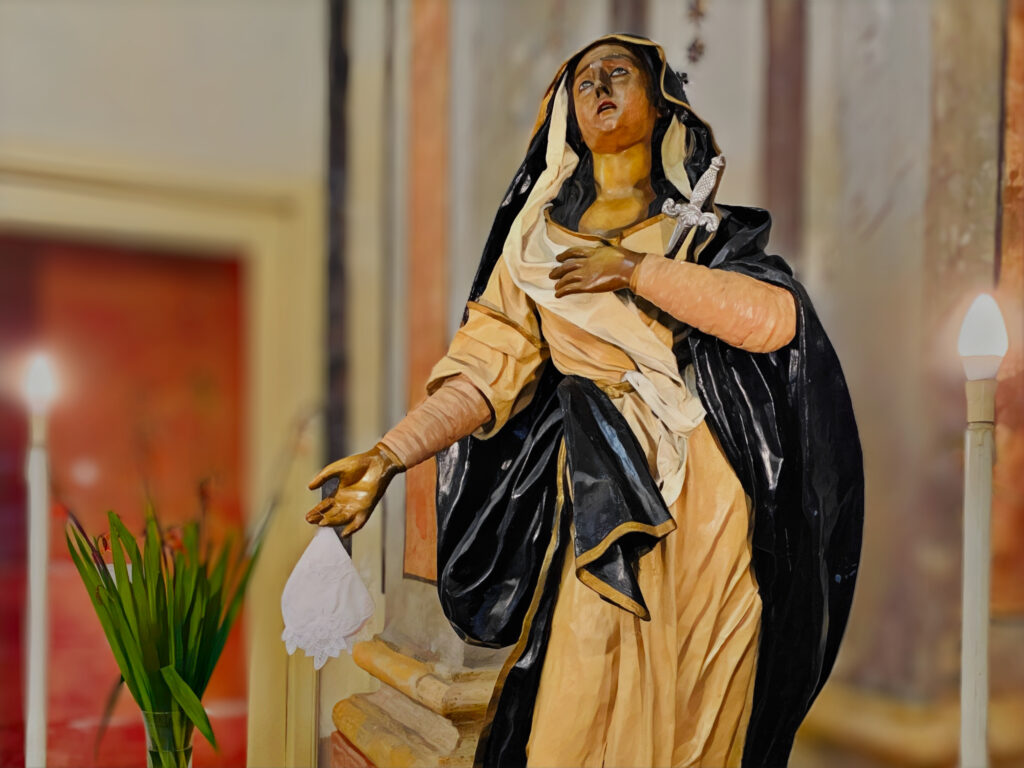
The procession of Maria Addolorata in Taranto (the procession of the Most Blessed Virgin of Our Sorrows) is another impressive and moving Holy Week procession in Puglia. It takes place on Holy Thursday, which is the Thursday before Easter Sunday.
The procession is organized by the Confraternity of the Most Holy Crucifix, and it begins at the church of San Domenico in the old town of Taranto. The highlight of the procession is the statue of Maria Addolorata, which is carried through the streets on the shoulders of the confraternity’s members.
The statue of Maria Addolorata represents the Virgin Mary mourning the death of Jesus, and it is beautifully adorned with flowers, candles, and other decorations. The statue is accompanied by a band playing somber music, and the participants in the procession are dressed in traditional costumes.
The procession winds its way through the narrow streets of the old town, pausing at several points along the way to allow the members of the confraternity to offer prayers and incense. The atmosphere is solemn and reverent, and the people who line the streets to watch the procession are quiet and respectful.
The procession of Maria Addolorata in Taranto is a powerful expression of the deep religious faith and cultural traditions of Puglia. It is a time when the people of Taranto come together to remember and reflect on the Passion of Christ and the sacrifice made for them. For those who witness it, the procession is a deeply moving and unforgettable experience.
The Procession of the Most Blessed Virgin of Our Sorrows starts at midnight between Holy Thursday and Holy Friday from the Church of San Domenico Maggiore and lasts about 14 hours.
The brothers of the Confraternity wear the traditional dress. A white tunic tight on the waistline and on the wrists, a black rosary hanging from the waistline with sacred medals and a crucifix, hanging on the right side of the tunic. Around the waits a black belt with white edge and four stripes, a front buttoned black mozzetta with a white edge with a metal medal portraying the Dolorous Mother, a black hat with a white edge, leaning on the shoulders and fixed on the waistline with a ribbon. On their heads a white hood with two holes corresponding to the eyes and a crown of twigs on their head; white tights and gloves; black shoes with white cockades and a black button.
The procession is composed of the Troccola, the instrument which opens the procession, the Pèsare representing the stones thrown at Jesus Christ, the Cross of Mysteries, the Third Cross, the Second Cross, the First Cross, the Throne, and finally the statue of the Most Blessed Virgin of Our Sorrows, carried by the Confraternity of SS. Maria Addolorata and San Domenico.
Two musical bands playing the funeral marches accompany the procession. Furthermore there are four couples in front of the Cross-bearers and other two in front of the Throne as well as two people carrying a mace responsible for keeping the procession in order and replace the brother in case of necessity.
Taranto | The Procession of the Mysteries
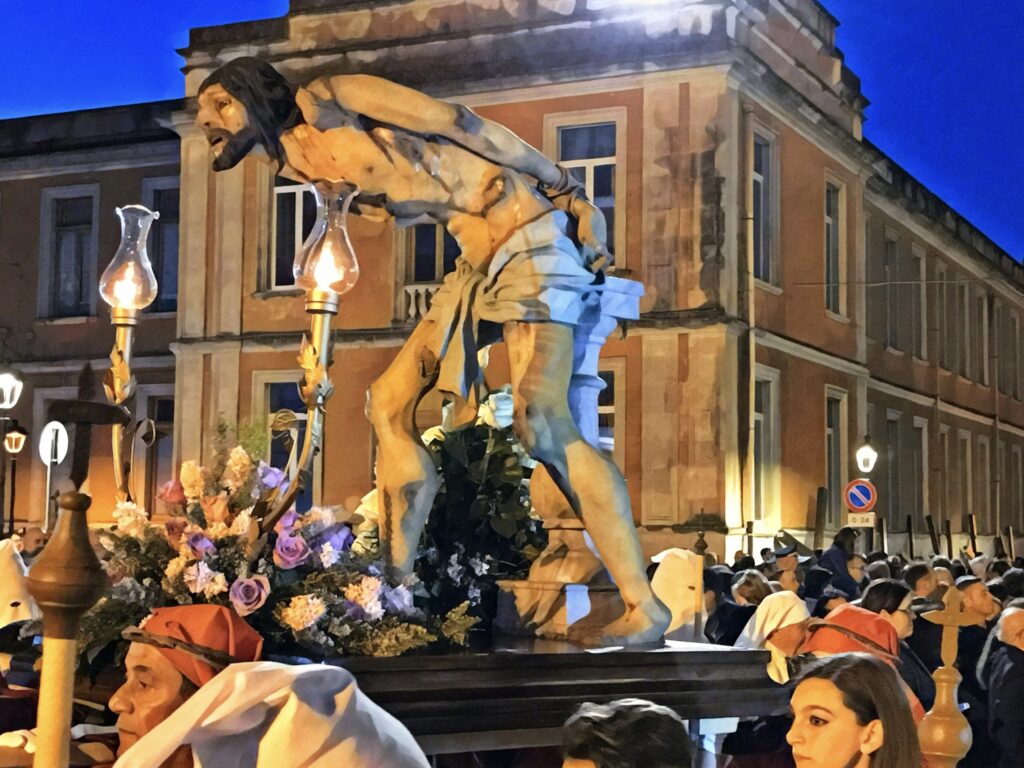
Another solemn and impressive Holy Week tradition that takes place on Good Friday. This procession is organized by the Confraternity of the Mysteries, and it is one of the most important events in the Holy Week celebrations in Taranto.
The procession involves the procession of 20 wooden statues, each representing a scene from the Passion of Christ. The statues, known as “Misteri” in Italian, are works of art and are carried on the shoulders of members of the confraternity.
The procession begins at the Church of San Francesco di Paola and winds its way through the historic streets of Taranto, stopping at various points to allow the members of the confraternity to recite prayers and offer incense.
The statues are illuminated by torches and accompanied by somber music played by a band. The participants in the procession are dressed in traditional costumes, and the atmosphere is one of solemnity and reverence.
One of the most striking features of the Procession of the Mysteries is the way in which the statues are carried. Each statue is carried in a unique way, with some being held upright and others being tilted at an angle. The procession is carefully choreographed, with the members of the confraternity moving in unison and with great reverence.
Overall, the Procession of the Mysteries in Taranto is a beautiful and moving expression of the religious and cultural traditions of Puglia. It is a time when the people of Taranto come together to remember and reflect on the Passion of Christ, and it is a testament to the deep faith and devotion of the people of the region.
This procession starts in the afternoon on Holy Friday from the Church of Carmine, carrying the statues which symbolize the passion of Christ and crossing Borgo Nuovo: it lasts about 15 hours.
The brothers wear the traditional dress of the so-called ‘Perdoni’ composed of a white tunic, a black belt, the rosary, the scapular (symbol of the devoted to Our Virgin of Carmine), a cream mozzetta, a black and blue hat, and a white hood tused to cover their faces.
All the brothers walk barefoot very slowly (it is said that they ‘nazzicano’, meaning ‘they rock’ to the rhythm of the funeral music).
The procession is composed of the ‘Troccola’, the instrument which opens the procession, the ‘Gonfalone’, which is the flag of the confraternity, the Cross of the Mysteries, Christ praying in the Olive Grove, the Column, Ecce Homo, the ‘Cascata’, the Crucifix, the Holy Shroud, Dead Christ, and the Most Blessed Virgin of Our Sorrows. There are also three couples in front of the statues and seven ‘maces’ responsible for keeping the procession in order and replace the brother in case of necessity.
The procession comes back to the Church of Carmine in the morning of Holy Saturday. The funeral marches played by the local musical bands are among the most important features of the Holy week in Taranto.
Overall, Easter in Puglia is a time of deep religious significance, and the traditions and rituals associated with the occasion are meant to inspire feelings of reverence and reflection. While the atmosphere can be dark and solemn, it is also a time of great spiritual meaning and cultural richness.
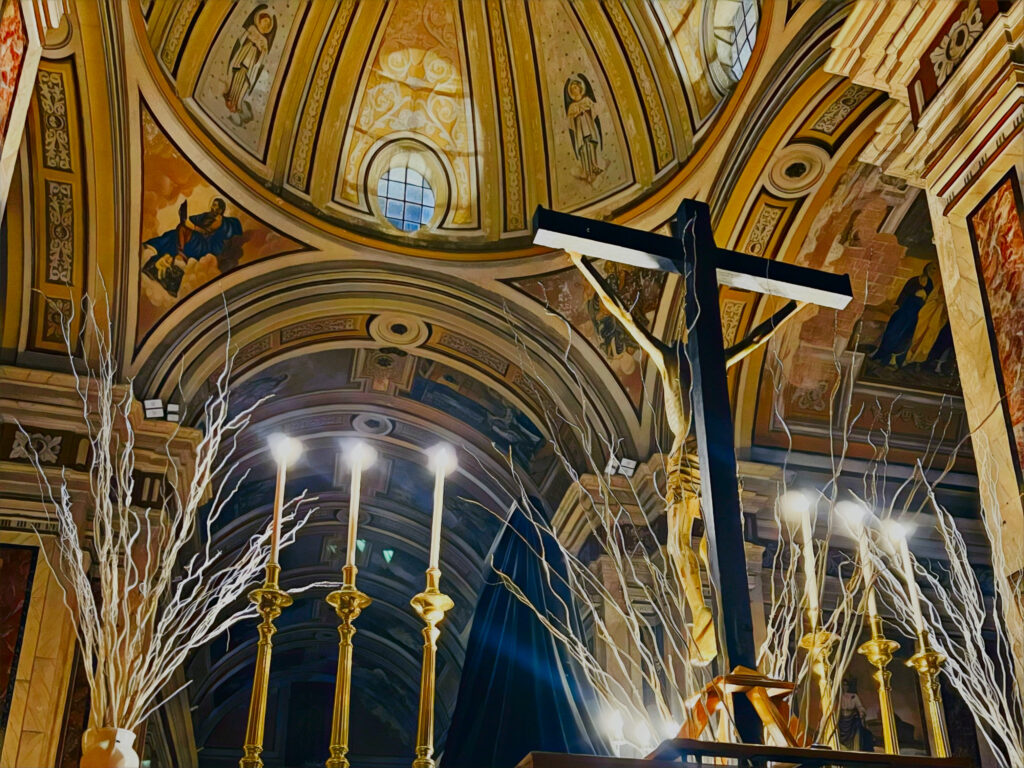
More | Puglia by cake: the Easter Trinity
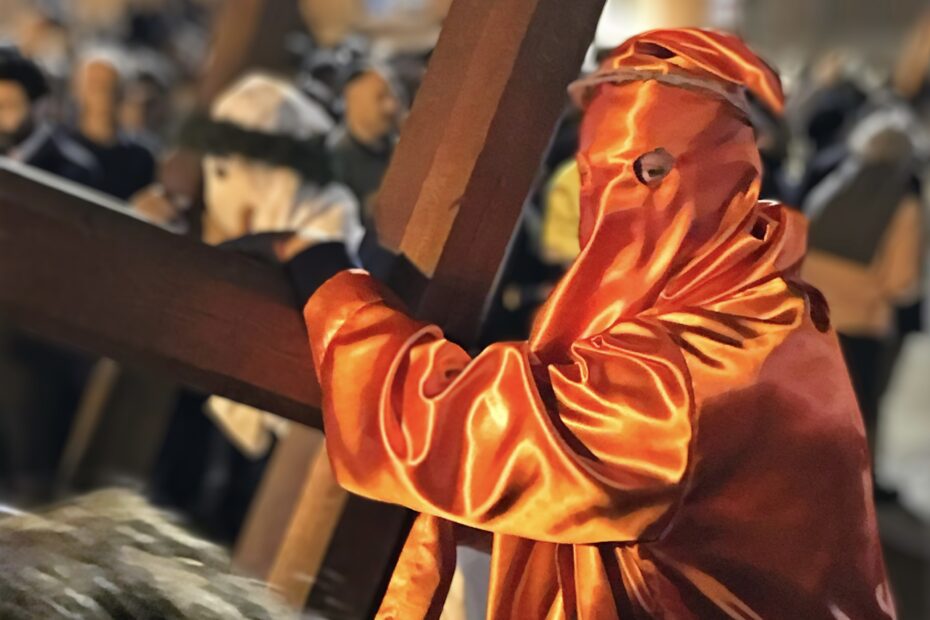
Wow Puglia must be so atmospheric in the lead up to Easter, I got a chill when I saw some of your pictures. It strikes me as a region that is still very deeply connected ad rooted in their traditions and not water down by tourism (even tho I’m sure this helps and an event like this is not to be missed). Germans also have the tradition to bake a sweet bread or cake in the shape of an Easter lamb and I saw Spain has a similar tradition. Makes me feel more connected to Italy and Spain, showing how similar our customs are. Same same but somehow still different.
Carolin | Solo Travel Story
Grazie. It’s very true what you say about traditions connecting us. Another example is music. We especially find traditional music links us not only with the Mediterranean connections. When we hear the fisarmonica (accordion) it invokes Germany, Munich especially, and Scotland.
Interesting read about these different traditions. I’m not religious, but I do like learning about it a country’s history with religion. I’d like to see one of these in person.